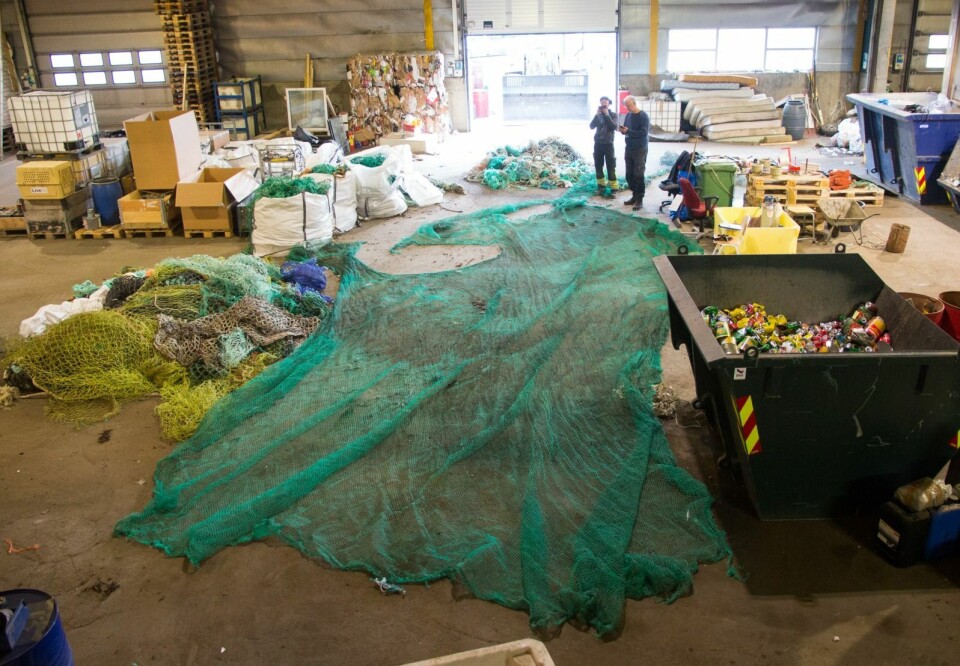Why fishing nets end up on Svalbard
Every year, many pieces of fishing net wash up on the shores of Svalbard and pose a serious threat to wildlife.

Denne artikkelen er mer enn fem år gammel.
Every year, many pieces of fishing net wash up on the shores of Svalbard and pose a serious threat to wildlife. Many reindeer, for example, have been found dead with their antlers entangled in the nets. To find out why these nets end up on our shores and where they originate from, Wouter Jan Strietman (Wageningen Economic Research) and Klaas-Jelle Koffeman (ex-fisherman) carried out an investigation at the local waste management facility (Avfallsmottaket Longyearbyen). To their surprise, it turned out that almost all of the nets had been discarded at sea.
During the summer of 2017, a lot of volunteers have been collecting litter from the beaches around Svalbard. These cleanups have been initiatied by organisations such as Svalbard Turn/Aktiv i Friluft (Prosjekt Isfjorden), Sysselmannen and AECO (cruise passengers). Not all of the collected litter is in the waste management facility yet, but so far already 20.000 kilos is stored there, around 7000 kilos of which is fishing nets. As such, the fisheries is one of the most important sources of litter on the beaches of Svalbard.
During the investigation at facility, around 2.000 kilos of these fishing nets were analysed, 43 parts in total. Every piece of net was first disentangled and then put on the floor of the facility for further investigation. All of the nets were thoroughly checked to see whether they had any signs of being torn or cut. Also, the type of fisheries involved and the age of the nets were examined. The insights from a workshop, organised by the MARP project (www.marp.no) in 2016, where a group of researchers and fishers looked through a container of fishing waste in Longyearbyen, inspired this year's investigation by the Dutch team to specifically look into the reasons why fishing nets have been ending up on the shores of Svalbard. This was the first time such a thorough examination has taken place.
This year’s investigation delivered important results. Through analysing the 43 nets, it became clear that almost all of these were actually parts of nets that had been replaced by new ones after they got damaged. Since the repairs have been taken place on board fisheries vessels, where the replaced parts could have been stored, it was clear that most of these nets had been deliberately discarded at sea. Many of these discarded nets exceeded 10 square metres, some more than 20.
Ex fisherman Klaas-Jelle Koffeman was surprised about the results of this investigation: “I was not expecting to find out that so many of these nets had actually been discarded at sea. Most fishermen take very good care of the environment and won’t discard their nets or other litter, but some obviously still do. Since the solution to this problem is easy and straightforward, this can easily be prevented. As one of the economic activities present in the Arctic ocean, we feel a responsibility in protecting the marine environment, which is both the source of our income and food for millions of people. By taking the right steps, making the Arctic clean again is something that is within our reach."
Discarding nets poses a serious problem for the environment, but also a problem that can be solved as it is related to human behaviour on board fishing vessels. Working on solutions with the fisheries sector and other stakeholders is the aim of the Arctic Marine Litter Action Plan project. The aim of this project is to prevent marine plastic pollution in the Svalbard region by identifying the sources of litter and supporting local and international stakeholders in the development of an action plan for marine litter. The project is coordinated by Wageningen Economic Research and carried out in close collaboration with Aktiv i Friluft, Oceanwide Expeditions and the MARP project, led by Jannike Falk-Andersson at Norut.
We wish to thank Hans Petter Lauritsen for providing information about the amount of kilos and type of litter collected this year and the help he and his colleagues provided in carrying out the investigation at the facility. We are also very grateful to Silje Hagen for her help in translating this article.
Wouter Jan Strietman and Klaas-Jelle Koffeman
